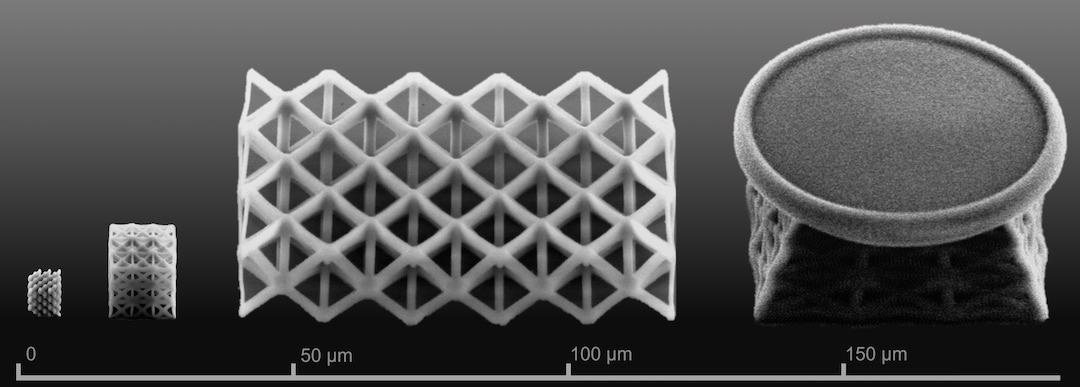Rice University engineers have set the stage for weaving intricate, microscopic patterns of glass or crystal.
 Delicate structures printed by materials scientists at Rice University as seen in microscope images. Sintering turns them into either glass or cristobalite. Image Credit: Nanomaterials, Nanomechanics and Nanodevices Lab.
Delicate structures printed by materials scientists at Rice University as seen in microscope images. Sintering turns them into either glass or cristobalite. Image Credit: Nanomaterials, Nanomechanics and Nanodevices Lab.
Materials scientists from Rice University are making nanostructures of silica with an advanced 3D printer, illustrating a technique to create micro-scale electronic, mechanical and photonic devices from the bottom up. The products could be doped and their crystal structures tuned for several applications.
The study headed by Jun Lou, a professor of materials science and nanoengineering at the George R. Brown School of Engineering, has been published in the Nature Materials journal.
The electronics sector is based on silicon, considered to be the basic semiconducting substrate for microprocessors for several years. The Rice study meets the restrictions of top-down manufacturing by turning the process upside-down.
It’s very tough to make complicated, three-dimensional geometries with traditional photolithography techniques. It’s also not very ‘green’ because it requires a lot of chemicals and a lot of steps. And even with all that effort, some structures are impossible to make with those methods.
Jun Lou, Professor of Materials Science and Nanoengineering, George R. Brown School of Engineering, Rice University
“In principle, we can print arbitrary 3D shapes, which could be very interesting for making exotic photonic devices. That’s what we’re trying to demonstrate,” added Lou.
The laboratory makes use of a two-photon polymerization process to print structures with lines measuring a width of only several hundred nanometers, which is smaller compared to the wavelength of light. Lasers “write” the lines by prompting the ink to absorb two photons, starting the material’s free-radical polymerization.
Normal polymerization involves polymer monomers and photoinitiators, molecules that absorb light and generate free radicals. In our process, the photoinitiators absorb two photons at the same time, which requires a lot of energy. Only a very small peak of this energy causes polymerization, and that in only a very tiny space. That’s why this process allows us to go beyond the diffraction limit of light.
Boyu Zhang, Study Co-Lead Author and Graduate Student, Rice University
Zhang is the co-lead author of the study describing the process that generally makes use of ultraviolet light in 3D printing and to cure coatings and in dental applications.
For the printing process, the Rice laboratory needed to design a special ink. Zhang and co-lead author Xiewen Wen, a Rice alumnus, made resins comprising nanospheres of silicon dioxide doped with polyethylene glycol to make them dissolvable.
Once printing is done, the structure is solidified via high-temperature sintering, removing all the polymer from the product, thereby leaving polycrystalline cristobalite or amorphous glass.
When heated, the material goes through phases from glass to crystal, and the higher the temperature, the more ordered the crystals become.
Jun Lou, Professor of Materials Science and Nanoengineering, George R. Brown School of Engineering, Rice University
Furthermore, the laboratory showed how the material is doped with several rare-earth salts to make the products photoluminescent. It is considered an essential property for optical applications. The next aim of the lab is to improve the process to achieve sub-10 nm resolution.
The co-authors of the study are Rice assistant research professor Hua Guo, research scientists Guanhui Gao and Xiang Zhang, alumnus Yushun Zhao, and graduate students Qiyi Fang and Christine Nguyen; Rice alumnus Fan Ye of Tsinghua University, Beijing; University of Houston alumnus Shuai Yue, who is currently a postdoctoral researcher at the Chinese Academy of Sciences; and Jiming Bao, a professor of electrical and computer engineering at the University of Houston.
The co-principal investigators of the study are Rice alumnus Weipeng Wang, who is currently a professor at Tsinghua University, China; and Rice’s Jacob Robinson, an associate professor of electrical and computer engineering and bioengineering, and Pulickel Ajayan, chair of the Department of Materials Science and NanoEngineering, the Benjamin M. and Mary Greenwood Anderson Professor in Engineering and a professor of chemistry.
The study was financially supported by the Welch Foundation (C-1716, E-1728).
Journal Reference:
Wen, X., et al. (2021) 3D-printed silica with nanoscale resolution. Nature Materials. doi.org/10.1038/s41563-021-01111-2.